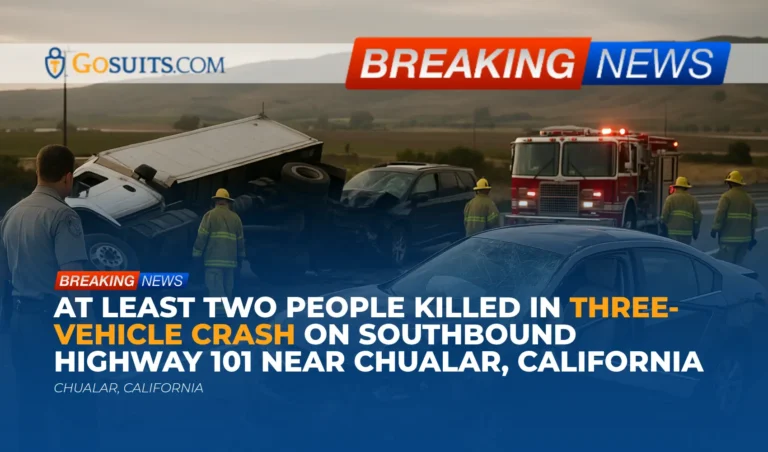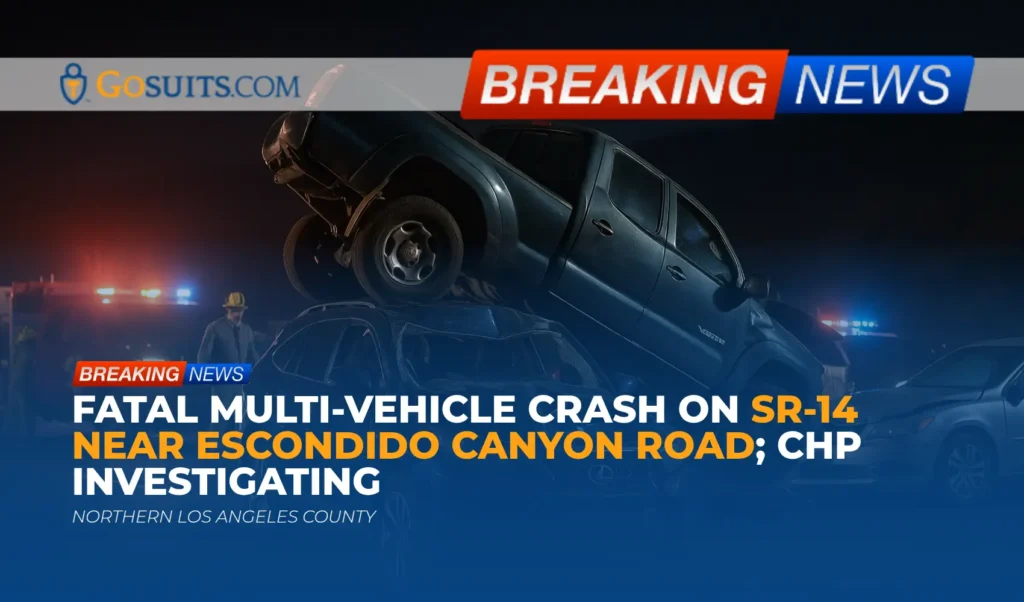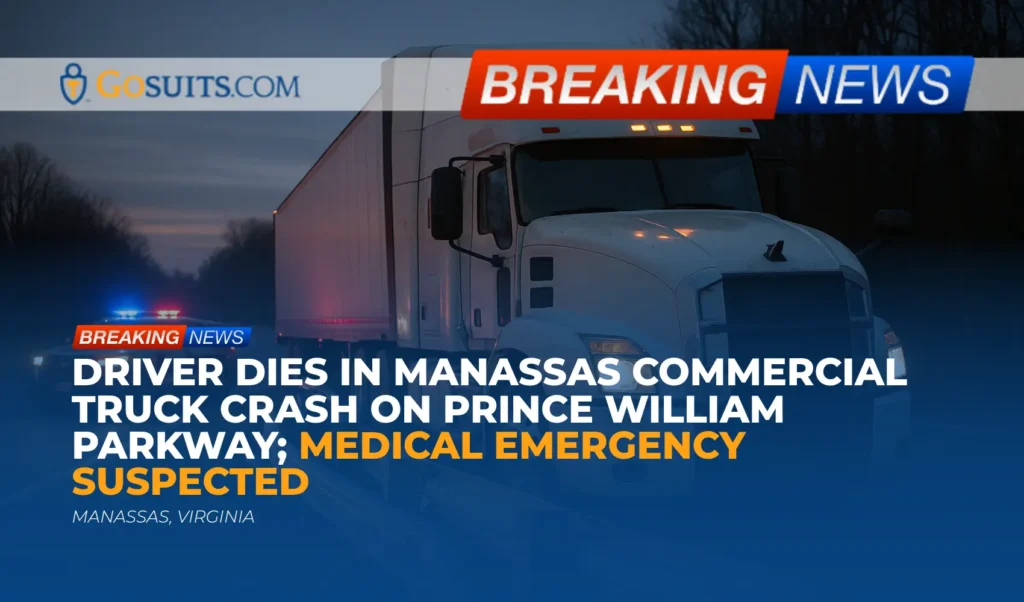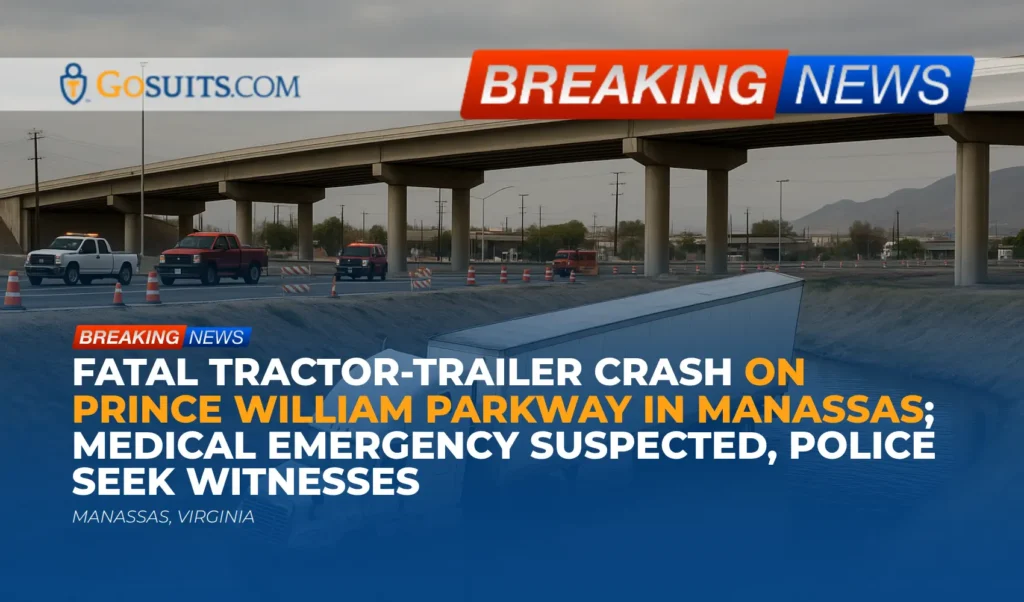- Overview of the reported crash in Chualar, California
- What is known so far and what remains unclear
- Immediate steps after a serious highway crash
- How fatal highway collisions are investigated in California
- Civil liability in a three‑vehicle fatal collision
- Insurance coverage considerations and common pitfalls
- Key legal time limits that may apply
- Where families can obtain official information and records
- Safety context for US‑101 in Monterey County
- Handling insurance communications with care
- How attorneys typically evaluate multi‑vehicle fatal crashes
- Commentary from Gosuits Chualar, California Personal Injury Attorney
- Time‑sensitive actions to consider now
Overview of the reported crash in Chualar, California
On Sunday evening, a multi‑vehicle collision involving three vehicles was reported on southbound Highway 101 near Chualar in Monterey County. According to preliminary information shared with local media by the California Highway Patrol (CHP), the crash was reported around 6:51 p.m., and at least two people lost their lives. CHP indicated a road closure was planned on the southbound side of Highway 101 just north of the collision site while responders worked the scene and investigators documented evidence. Details remain limited at this stage, and official agencies have not yet released comprehensive findings about how the collision occurred or the identities of those involved.
For families, friends, and the broader community, news like this is devastating. Early hours and days are often marked by shock, confusion, and a pressing need for reliable information. The information below explains the steps public agencies typically take, how investigative findings are compiled, and where loved ones can obtain official records. It also outlines general civil legal concepts that may be relevant in a fatal highway collision in California.
What is known so far and what remains unclear
Confirmed facts
- Location: Southbound Highway 101 in the Chualar area of Monterey County.
- Time: Approximately 6:51 p.m. on a Sunday evening.
- Vehicles: Reported as a three‑vehicle collision.
- Outcomes: CHP confirmed at least two fatalities.
- Traffic impact: CHP planned a road closure on SB‑101 north of the crash scene to facilitate response and investigation.
Information not yet available
- Cause and sequence: Which vehicle initiated the sequence, contributing factors, and precise crash dynamics are not yet publicly known.
- Identities and conditions: Names of those involved and the condition of any survivors have not been released.
- Whether commercial or government vehicles were involved: This can affect insurance and potential liability but is unknown at this time.
- Official investigative findings: These typically become available after CHP completes its collision report and, if applicable, specialized reconstruction analysis.
Because early reports are often preliminary, it is prudent to wait for official updates before drawing conclusions.
Immediate steps after a serious highway crash
In the aftermath of a fatal highway crash, several practical steps can help protect safety, preserve information, and support any future claims. The following points are general and may not apply to every situation.
- Ensure safety first. Move to a safe location if possible and follow the directions of first responders.
- Document what you can. If it is safe and appropriate, photographs of vehicle positions, road markings, debris fields, skid marks, and weather or lighting conditions can be helpful.
- Identify witnesses. Collect names and contact details of anyone who saw what happened.
- Preserve vehicles and data. Vehicles often contain event data recorders and other electronic data; preservation is important for later analysis.
- Avoid detailed statements to insurers before legal guidance. Statements can be used later to influence fault determinations. Consider seeking legal advice first.
- Seek medical attention. Even if injuries seem minor, prompt evaluation documents injuries and links them to the crash.
How fatal highway collisions are investigated in California
When a fatality occurs on a state highway, CHP conducts a formal investigation. Depending on the severity and complexity, CHP may deploy a Multidisciplinary Accident Investigation Team (MAIT), which specializes in advanced collision reconstruction and causation analysis. MAIT teams analyze vehicle dynamics, roadway design, human factors, and mechanical issues. More information about MAIT can be found through the CHP program page at CHP MAIT.
Typical evidence collected
- Scene documentation: Measurements of tire marks, gouge marks, debris, final rest positions, and roadway geometry.
- Vehicle inspections: Crush profiles, restraint usage, airbag modules, and mechanical condition.
- Electronic data: Event data recorders (EDRs) capturing speed, braking, throttle, and seatbelt status seconds before impact.
- Environmental factors: Lighting, weather, signage visibility, and work zones.
- Human factors: Possible impairment indications, fatigue, distraction, and training/experience if a commercial driver is involved.
Timeframes and access
CHP prepares a Traffic Collision Report, typically using the CHP 555 format. The report is not always immediately available; complex fatal collisions can take weeks or months to finalize. Eligibility and process for requesting reports are explained by CHP here: Obtaining copies of collision reports (CHP).
Civil liability in a three‑vehicle fatal collision
In California, liability for a multi‑car crash can involve one or multiple drivers, vehicle owners, employers (if a driver was acting within the scope of employment), contractors responsible for roadway conditions, or other parties whose negligence contributed to the collision.
Negligence and comparative fault
Most traffic collision claims are evaluated under negligence principles: duty, breach, causation, and damages. California uses a comparative fault framework, which means responsibility can be proportionally shared among multiple parties. Jurors are instructed that a plaintiff’s damages may be reduced by their percentage of fault, if any. The Judicial Council’s civil jury instruction on comparative fault is available here: California Civil Jury Instructions, CACI No. 405.
Wrongful death claims
When a life is lost due to another’s negligence or wrongful act, certain surviving family members may bring a wrongful death claim for losses such as loss of financial support and companionship. A separate survival action may address damages the decedent incurred before death. The availability and scope of these claims depend on California statutes and the facts established by official investigations and evidence.
Potentially responsible parties in a three‑vehicle collision
- One or more drivers: Speeding, unsafe lane changes, following too closely, impairment, or distraction can all contribute.
- Vehicle owners: Liability can arise from negligent entrustment or permissive use depending on circumstances.
- Employers: If a driver was on the job, vicarious liability may apply.
- Public entities or contractors: In rare situations, roadway defects, inadequate signage, or construction-zone issues may be implicated, subject to statutory immunities and strict notice requirements.
- Product manufacturers: If evidence suggests a vehicle or component failure contributed, product liability theories may be explored.
Determining fault in a chain‑reaction or multi‑impact crash requires careful reconstruction. Early preservation of vehicles, data, and scene evidence is essential.
Insurance coverage considerations and common pitfalls
California’s minimum liability limits increased in 2025. For policies issued or renewed on or after January 1, 2025, minimum auto liability coverage is generally 30/60/15: $30,000 per person bodily injury, $60,000 per incident bodily injury, and $15,000 property damage. See the California Department of Insurance’s consumer notice regarding updated minimums: California Department of Insurance: New Minimum Liability Limits.
Key coverage types that may be relevant
- Liability coverage: Pays for injuries and damages the at‑fault driver legally owes, up to policy limits.
- Uninsured/Underinsured Motorist (UM/UIM): Helps when the at‑fault driver lacks sufficient insurance. Consumer guidance is available from the Department of Insurance here: UM/UIM coverage overview.
- Medical payments (“Med‑Pay”): No‑fault medical coverage that can assist with immediate medical bills, subject to policy terms.
- Commercial policies: If a business or commercial vehicle is involved, higher limits and additional coverage layers (umbrella or excess) may be available.
- Wrongful death and survival damages: Different categories of damages can apply under separate legal claims.
Common pitfalls
- Early recorded statements: Insurers sometimes ask for recorded statements shortly after a crash. Statements can be used to minimize responsibility or damages. Consider speaking with an attorney before communicating in detail with any insurer.
- Premature settlements: Early offers can arrive before the full extent of losses and insurance coverage is understood.
- Missing additional coverage: UM/UIM and umbrella policies can be overlooked if policy documents are not carefully reviewed.
Key legal time limits that may apply
California law imposes strict deadlines for civil claims. These are general timelines and may vary depending on the facts; other deadlines can apply.
- Personal injury and wrongful death: In many cases, a two‑year statute of limitations applies under Code of Civil Procedure section 335.1.
- Claims involving public entities: If a claim may be asserted against a public entity, written notice is often required within six months of the incident under Government Code section 911.2, with additional timing rules for lawsuits in Government Code section 945.6.
Because deadlines can be outcome‑determinative, it is important to identify all potentially responsible parties early and track the appropriate time limits for each.

Where families can obtain official information and records
Families often need timely, accurate records to understand what happened and to manage necessary arrangements. These agencies are the primary sources for official information following a fatal highway collision in Monterey County.
CHP collision report
Eligible parties (such as involved individuals, their representatives, or next of kin) may request the Traffic Collision Report from CHP. The agency explains eligibility, timing, and required forms here: CHP: Obtaining copies of collision reports. Requestors typically use form CHP 190 and submit it to the appropriate CHP Area office.
Monterey County Sheriff‑Coroner’s Office
The Sheriff‑Coroner is responsible for determining cause and manner of death and for maintaining related records. Information about the Coroner function and contact details are available on the county website: Monterey County Sheriff‑Coroner. Families can inquire about death notifications, autopsy status, and how to request coroner reports. Note that processing times may vary, especially if toxicology testing is required.
Death certificates
Certified copies of death certificates are usually available through the county recorder’s office after the certificate is registered. Monterey County provides instructions for obtaining vital records on its official site. Check the county’s vital records pages for current procedures and identification requirements.
Road closures and traffic conditions
- Caltrans QuickMap: For live closure and incident updates, Caltrans provides its statewide QuickMap at quickmap.dot.ca.gov.
- Caltrans District 5: Chualar lies within Caltrans District 5, which posts regional information here: Caltrans District 5.
Other information sources
- CHP traffic incident logs: CHP maintains incident information that can help track roadway conditions and closures. Availability and detail can vary.
- Towing and vehicle release: CHP or the responding law enforcement agency can advise which tow operator removed vehicles and what steps are needed for release or inspection.
Safety context for US‑101 in Monterey County
US‑101 is a major corridor serving local, regional, and interstate traffic. Traffic volumes, the mix of passenger and commercial vehicles, and changing weather or lighting conditions can contribute to crash risk. While comprehensive crash statistics specific to the immediate area may take time to update, Caltrans and CHP regularly assess and address safety on state highways through engineering, enforcement, and education. General California highway safety initiatives and traffic management information are accessible through Caltrans and CHP resources, including Caltrans District 5 updates at Caltrans District 5 and CHP safety programs like CHP MAIT.
Nationwide, agencies such as the National Highway Traffic Safety Administration publish highway safety research and guidance that informs state and local efforts. For general context on crash causation and roadway safety strategies, NHTSA’s research and data pages are available at nhtsa.gov.
Handling insurance communications with care
In a multi‑vehicle fatal collision, multiple insurers may become involved, including liability carriers for each driver and UM/UIM carriers for affected parties. What is said to any insurer can affect the path of a claim.
- Seek legal guidance before contacting insurers. It is prudent to consult an attorney first. Communications can be recorded, and statements may be interpreted in ways that reduce or shift fault.
- Provide only basic information when necessary. If immediate notice is required under a policy, keep to factual basics and avoid speculation about fault or injuries until you have legal advice.
- Centralize documentation. Maintain a file with claim numbers, adjuster names, policy documents, medical records, funeral expenses, and correspondence.
- Be cautious with medical authorizations. Broad releases can give insurers access to unrelated medical history. Narrow releases are often more appropriate and should be reviewed carefully.
How attorneys typically evaluate multi‑vehicle fatal crashes
Experienced injury attorneys approach multi‑car fatal collisions methodically, focusing on causation, liability, coverage, and damages. While every case is unique, common evaluation steps include:
- Scene and vehicle evidence review: Obtain the CHP report, photographs, total station diagrams, EDR data, and tow yard inspections.
- Witness and first responder interviews: Clarify vantage points, sequence of impacts, lighting, and roadway conditions.
- Specialist consultation: Collision reconstructionists, human factors professionals, and, where relevant, trucking safety or roadway design consultants may be engaged to analyze complex mechanisms.
- Insurance mapping: Identify all policies, including liability, UM/UIM, umbrella, and employer coverage, and confirm policy periods and exclusions.
- Damages assessment: Document economic losses, including funeral costs and loss of support, and non‑economic harms recognized by California law.
- Notice and preservation: Send preservation letters to safeguard vehicles, EDR data, dashcam or surveillance footage, and telematics.
In some cases, early involvement can make a tangible difference in preserving critical evidence that might otherwise be lost, especially electronic vehicle data and short‑retention video footage from nearby sources.
Commentary from Gosuits Chualar, California Personal Injury Attorney
Our hearts go out to everyone affected by the reported crash on southbound Highway 101 near Chualar. This article is intended for general educational purposes and to provide helpful context while official information is still developing. Losing a loved one in a sudden collision is a profound loss, and the uncertainty that follows can be overwhelming.
Based on what is publicly known, this was a three‑vehicle crash with at least two fatalities and a significant traffic response. In such multi‑vehicle situations, fault can be shared or rest with a single driver, and the sequence of impacts matters. Until CHP completes its investigation and any specialized reconstruction, it is not possible to pinpoint causes. That is why evidence preservation and careful review of official findings are so important.
Insurance companies and large corporations are sophisticated in the way they respond to serious crashes. Adjusters may reach out quickly, request statements, or offer early settlements. These interactions happen at a time when people are grieving and may not yet know the full picture of coverage or losses. Without guidance, it is easy to say something that gets taken out of context or to accept an offer that does not account for all available insurance or long‑term harms.
A free consultation with a seasoned attorney can help clarify rights, identify potential sources of recovery, and plan next steps before any detailed conversations with insurers. It also provides a safe place to ask questions, understand timelines, and prioritize evidence preservation. No one should have to navigate these complexities alone or feel rushed into decisions while still waiting for official reports.
Time‑sensitive actions to consider now
The following general steps highlight why timely action matters after a serious highway collision. These are not directed to any one person and are intended to outline common considerations.
- Preserve vehicles and data immediately. Event data recorders, dashcam footage, and surveillance video from nearby properties can be overwritten or lost within days. Prompt preservation letters and inspection arrangements are crucial.
- Request official records as they become available. Initiate requests for the CHP collision report using the CHP process described here: CHP collision report requests. For coroner records, monitor updates from the Monterey County Sheriff‑Coroner.
- Track all deadlines now. Calendar the two‑year civil statute identified in CCP 335.1 and, if any public entity could be involved, the six‑month claim requirement under Gov. Code 911.2. Missing these can bar claims.
- Centralize insurance information. Gather all relevant auto, umbrella, and UM/UIM policies for every potentially affected household member. Review California’s updated minimum limits through the Department of Insurance at this page, and confirm actual limits on each policy.
- Document economic losses in real time. Keep receipts and records for funeral and memorial expenses, travel for family coordination, time off work, and counseling or support services. Accurate documentation helps ensure losses are fully considered.
- Consult an attorney before insurer communications. Before giving any recorded statement or signing authorizations, consider a free legal consultation to understand rights and potential impacts. What is said to insurers can be used to influence fault and damages.
- Monitor roadway updates and detours safely. Use Caltrans tools such as QuickMap and regional updates from Caltrans District 5 to plan travel around closures while investigators are working.
Acting promptly helps protect crucial evidence, clarifies coverage, and ensures important legal timelines are met.
Additional official resources

California Highway Patrol
- Collision report requests: CHP: Obtaining copies of collision reports
- Specialized investigations: CHP MAIT
Monterey County
- Sheriff‑Coroner Office: Monterey County Sheriff‑Coroner
- County updates and services: Official information may also be posted on the county’s website for public awareness and assistance.
Caltrans
- Live traffic and closures: Caltrans QuickMap
- Regional office: Caltrans District 5
California legal framework
- Statute of limitations: CCP § 335.1
- Public entity claims: Gov. Code § 911.2 and Gov. Code § 945.6
- Comparative fault instruction: CACI No. 405
- Auto insurance minimums (2025): Department of Insurance update
- UM/UIM guidance: Department of Insurance UM/UIM
As official information is released by CHP and the county, it can help families and their representatives understand what happened and what options may be available under California law. Throughout, it is important to remain respectful of the investigative process and the privacy of those involved.






